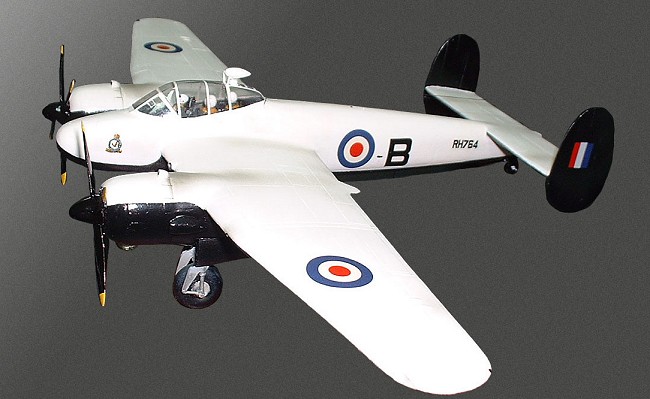
Hallam Vac 1/72 Bristol Brigand Mk.I
| KIT #: | ? |
| PRICE: | Ä15.00 MSRP |
| DECALS: | One option |
| REVIEWER: | Carmel J Attard |
| NOTES: | Vacuformed with metal parts |

| HISTORY |
The Brigand was planned as a Beaufighter replacement being a three seat light bomber. The type 164 prototype flew in December 1944 and was powered by two Centaurus VII radial engines. The Brigand B.Mk1 started to enter service in 1949. It was used extensively in the Malayan Emergency circa 1950-54 rendering it a highly effective and powerful weapon against communist insurgents.
The three men crew was housed in a cabin with good all round visibility. The type carried four 20mm cannons, which were mounted under the nose and rocket racks that were fitted under the wings. These were the main anti-shipping weapon. Heavy defensive armament configuration such as a rear gun at the expense of speed and offensive load was later on discarded.
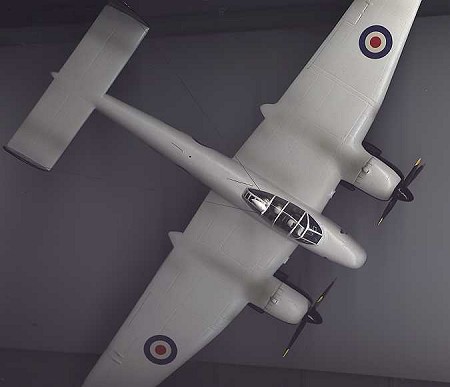 The Brigand performed
policing duties in Iraq, Aden, and Malaya. No.8 Squadron was Adenís
long-lived residing squadron and No.84 Sq. was based in Iraq being both
equipped with Brigands. Brigands are known for the numerous attacks on
terrorist camps in the jungle using bombs and rockets.
The Brigand performed
policing duties in Iraq, Aden, and Malaya. No.8 Squadron was Adenís
long-lived residing squadron and No.84 Sq. was based in Iraq being both
equipped with Brigands. Brigands are known for the numerous attacks on
terrorist camps in the jungle using bombs and rockets.
There was a time in 1951 when Brigands had to be grounded while faults involving propeller failures caused several crashes whereas premature explosions of H.E. shells resulted in the loss of others. By 1953 strike Brigands had been withdrawn from service making way for Hornets and Vampires for the ground attack role.
The Hallam-Vac kit of the Brigand has a decal sheet for a No.8 Sq aircraft. These reequipped from Tempest F6s at Khormaksar, Aden an July 1949. However conversion to Vampire FB9s began in December 2953. The Brigand RH764 being struck off charge on 25th February 1953.
Many Brigands were later on converted to radar training units designated T4s and were later on modified to T5s while continued in service until March 19568.
The Brigand gave useful service in Malaya flying 4513 sorties and was the last RAFs piston-engined light bomber. The total production was 4 prototypes and 135 production aircraft.
| THE KIT |
The kit is vac formed
in white forty- thou plastic sheet, which is neatly moulded into a number
of broken down detailed parts. Whereas the fuselage is split vertically,
each wing is split into upper and lower surfaces. A genuine way of moulding
is that Hallam-Vac of
Sheffield produces a 1/72-scale model of the Bristol Brigand B.Mk1., which
is a light ground attack bomber. This kit is now available at
www.aeroclub-models.com
The Brigand is a vacuum-formed scale model, which in spite of its
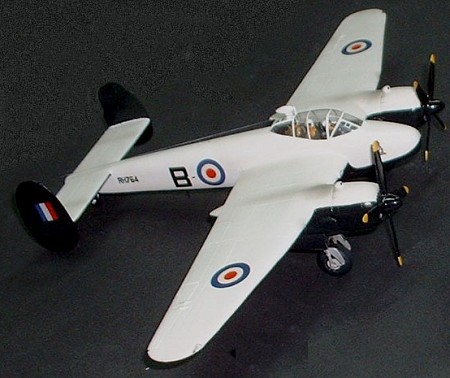 active service with
the RAF it is another of those combat aircraft that remain to be ignored by
the big kit manufacturers. This is such a surprise because well over 100 of
these were produced (143) and besides its active service with the RAF, it
was unique of being the last piston engine light bomber to serve.
active service with
the RAF it is another of those combat aircraft that remain to be ignored by
the big kit manufacturers. This is such a surprise because well over 100 of
these were produced (143) and besides its active service with the RAF, it
was unique of being the last piston engine light bomber to serve.
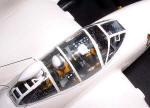 The upper wing
surface part has the dihedral moulded in, thus guaranteeing the apparent
wing upper tilt appearance on the end product. The twin fins and rudders,
the tail planes and engine nacelles are also split. The nacelles themselves
are quite sizeable, thus giving a lot of room for further detailing the
interior of the wheel wells. The plastic sheet also provides suitable
bulkheads as well as cockpit floor. A cockpit is provided which is made out
of very clear acetate. The cockpit itself is very spacious and the
instruction sheet provided with the kit also depicts a sketch to indicate
the 3-crew seats cockpit layout. Such arrangement can very easily be built
from scratch, same as I did with very effective result.
The upper wing
surface part has the dihedral moulded in, thus guaranteeing the apparent
wing upper tilt appearance on the end product. The twin fins and rudders,
the tail planes and engine nacelles are also split. The nacelles themselves
are quite sizeable, thus giving a lot of room for further detailing the
interior of the wheel wells. The plastic sheet also provides suitable
bulkheads as well as cockpit floor. A cockpit is provided which is made out
of very clear acetate. The cockpit itself is very spacious and the
instruction sheet provided with the kit also depicts a sketch to indicate
the 3-crew seats cockpit layout. Such arrangement can very easily be built
from scratch, same as I did with very effective result.
The other finer
parts that come with the kit are made of white metal and these include the
engine mounts, which are in the shape of detailed cooling fans; four bladed
propellers which have integrally cast large spinners; four large side air
intakes; the pilotís seat. (The other two seats for the radio officers have
to be made out of the spare plastic). T here
is also a control column; a DF loop, fine undercarriage legs and a tail
wheel. Each of these items is well moulded with minimum of flush and well
detailed.
here
is also a control column; a DF loop, fine undercarriage legs and a tail
wheel. Each of these items is well moulded with minimum of flush and well
detailed.
A four-view scale plans supplied. This depicts a B.Mk1 in white and black colour scheme for which a decal sheet to represent Brigand RH764, is supplied. This is excellent in quality but unfortunately it lacks the No8 Sq crest that is normally displayed on the nose sides of the aircraft. I have managed to do mine using a crest decal from an early ESCI sheet with a little of art work added to, but this can easily be painted on a blank decal sheet. Spare fin flashes for the inner fins has also to be produced from the spares box as only two instead of four are provided with the kit.
| CONCLUSIONS |
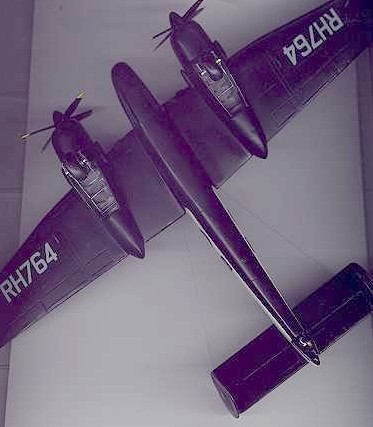 I always enjoy
making vac form kits and all that it takes is to take great care in cutting
the various parts and in rubbing them down to size. The assembly is then
very little different from that of a common injection moulded kit. This has
been described in greater detail in issue No5 of 2.1 KPM on another vac
form kit from Hallam-Vac excellent range of kits. The Hallam-Vac kit of the
Brigand was a nice and interesting model that was well worth its value for
money as well as in adding it to my aircraft model collection. This has
filled up an important part of RAF piston engined aircraft that served in
combat and that at one time used Hal-Luqa airfield in Malta as a staging
post on its way to the Far East.
I always enjoy
making vac form kits and all that it takes is to take great care in cutting
the various parts and in rubbing them down to size. The assembly is then
very little different from that of a common injection moulded kit. This has
been described in greater detail in issue No5 of 2.1 KPM on another vac
form kit from Hallam-Vac excellent range of kits. The Hallam-Vac kit of the
Brigand was a nice and interesting model that was well worth its value for
money as well as in adding it to my aircraft model collection. This has
filled up an important part of RAF piston engined aircraft that served in
combat and that at one time used Hal-Luqa airfield in Malta as a staging
post on its way to the Far East.
November 2005
Copyright Modeling Madness.com
If you would like your product reviewed fairly and fairly quickly, please contact the editor or see other details in the Note to Contributors.